Alabama is rich in geological diversity, offering a fascinating world of rocks, minerals, and gems just waiting to be explored. From the northern mountains to the southern coastal plains, every region presents its own unique set of geological wonders.
One of the most exciting aspects of the state’s geology is the variety of rocks that can be found. The types of rocks found here include sedimentary rocks like sandstone, metamorphic rocks like schist and marble, and igneous rocks like granite.
And for those who love the sparkle of gems, the state offers the chance to discover garnets, tourmaline, and even gold.
Every rock, mineral, and gem has its own tale, making Alabama a must-visit destination for rock enthusiasts and nature lovers alike.
A List of The Common Rocks, Stones, and Minerals Found in Alabama
Alabama’s geology is as diverse as its landscapes. Delve deeper into the rocks and minerals of the state and the fascinating processes that created them:
The Alabama State Rock, Mineral, and Gem
See the rock, mineral and gem that represent the state of Alabama:
| Alabama State Rock | Marble |
| Alabama State Mineral | Hematite |
| Alabama State Gem | Star Blue Quartz |
Rockhounding can be an exciting adventure, uncovering the state’s geological wonders. However, it’s important to know the rules and guidelines to make sure this activity is both fun and responsible.
The Alabama Department of Conservation and Natural Resources (ADCNR) is the go-to source for understanding what’s allowed and what’s not.
Agate
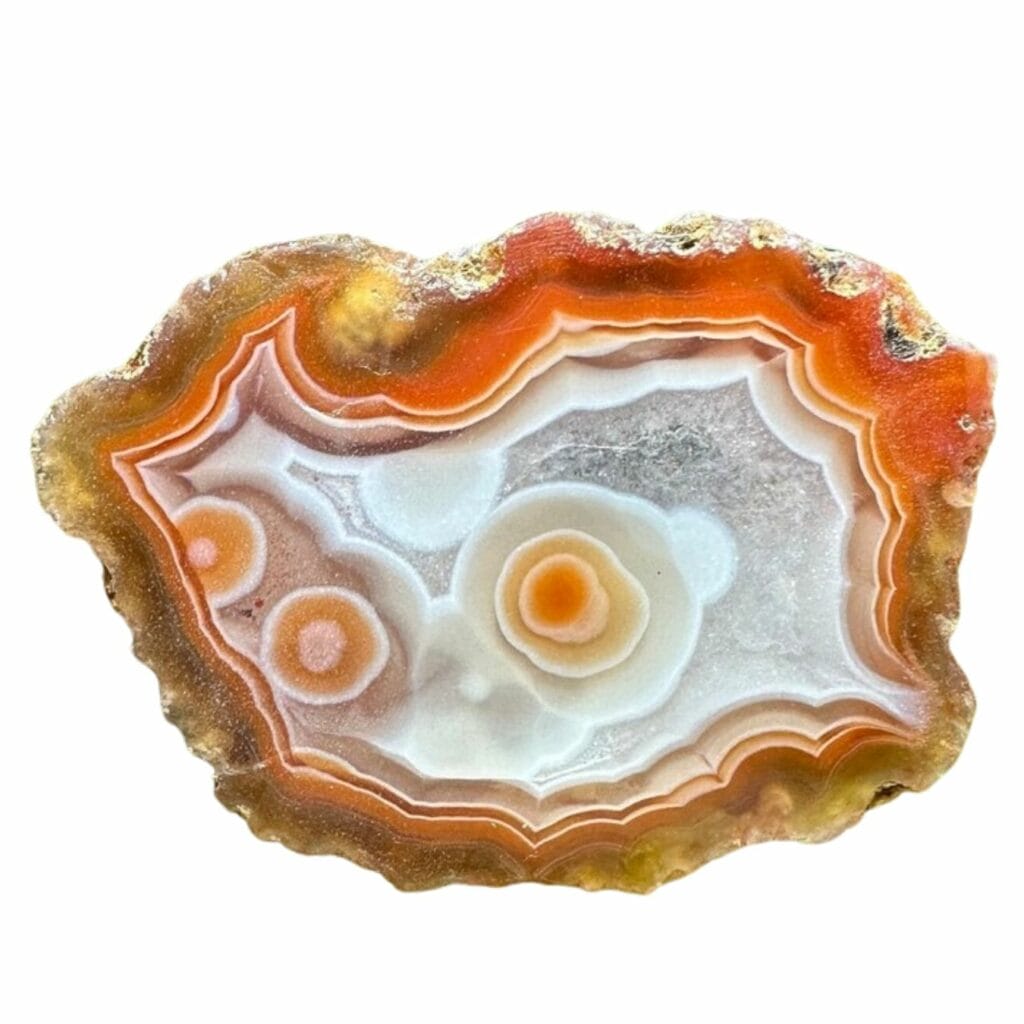
Agate is a fascinating and beautiful type of rock that you can find in Alabama, known for its stunning patterns and colors. It’s a form of quartz, which is a common mineral, but what makes agate special is how it forms and looks.
Agate forms when silica, a substance found in sand and rocks, gets into spaces in other rocks, like lava or other types of old, hard rocks.
Over a long time, this silica cools down and hardens into layers, creating the unique bands and patterns that agate is famous for.
The colors in agate come from different minerals that mix with the silica. These minerals can add a wide range of colors, from reds and oranges to blues and greens, making each piece of agate unique.
Sometimes, the conditions when the agate is forming can change, and this results in the different layers having different colors and patterns. This variety is part of what makes agate so appealing to people who love rocks.
In Alabama, agate is often found in areas where there were once volcanoes or other places with a lot of geological activity. Rivers and streams can also roll agate pieces smooth, making them even more attractive.
The beauty of agate is a big factor in its value. The more striking the patterns and colors, the more people might value it. Also, the rarity of the colors or patterns are can make a difference.
Agate is not just used for collecting; it’s also popular in jewelry and decorative items because of its beauty and durability. This makes agate a favorite among both rock collectors and artists who create beautiful things from natural materials.
Where you can find agate in Alabama
- Knoxville, Greene County
- Tuscaloosa, Tuscaloosa County
- Bingham Mountain, Jackson County
Calcite

Calcite is among the most common rocks and minerals found here. It’s made mostly of calcium carbonate, which is the same material that makes up seashells and coral.
It forms in many different ways, often when water that has calcium in it gets into cracks in rocks. Over time, as the water evaporates, the calcium carbonate is left behind and turns into calcite.
One of the neat things about calcite is that it can be found almost everywhere. It’s often seen in limestone, a type of rock that forms in layers, often under water.
When you find calcite in limestone, it can look like beautiful crystals or even like a part of the rock itself.
Calcite is also known for its ability to split light into two rays, a property called birefringence. This makes it look like objects seen through it are doubled.
The way the calcite forms into different shapes and colors can be really eye-catching. Also, because it’s so common, calcite is super useful in teaching about minerals and geology.
People also use calcite in making things like cement and as a part of the stuff that makes up toothpaste. So, while it might not be as flashy as some gems, calcite has its own special place in the world of rocks and minerals.
Where you can find calcite in Alabama
- Pinson, Jefferson County
- Ordovician limestones, Limestone County
- Angel Station Mining District, Calhoun County
Fluorite

Fluorite is a really cool mineral that’s known for its amazing range of colors – from purples and greens to yellows and blues. It’s made up of calcium and fluoride and forms when hot water filled with minerals flows through cracks in rocks.
As the water cools down, the minerals start to settle out and form crystals. This is how those stunning fluorite crystals are born.
What’s really neat about fluorite is that it can glow under ultraviolet light! This glowing property, known as fluorescence, is actually where the term gets its name. Not all fluorite glows, but when it does, it’s pretty spectacular.
The beauty of fluorite is a big draw. The variety of colors and the way the crystals form make each piece unique. Plus, fluorite is often used in making jewelry and decorative items because of its striking appearance.
Fluorite is also used in the making of steel and other metals and also in some types of glass and enamel. This blend of beauty and usefulness makes fluorite a standout mineral.
Where you can find fluorite in Alabama
- Dutch Bend Mine, Tallapoosa County
- Wills Valley, Etowah County
- Milltown, Chambers County
Gypsum

Gypsum is a really interesting mineral that’s known for being soft and for its white or clear crystals. It’ made of calcium sulfate and water, and it usually forms in places where saltwater lakes or seas have dried up over time.
When the water goes away, minerals like gypsum are left behind. Gypsum can be found in layers mixed with other types of rock.
One of the coolest things about gypsum is that it can form some pretty amazing shapes. There are the needle-like crystals called selenite, the flower-like forms known as desert roses, and the smooth, layered gypsum called alabaster.
Each of these forms is unique and shows the different ways gypsum can appear.
Gypsum has a lot of value, not just because it looks nice, but also because it’s super useful. It’s a key ingredient in plaster and drywall, which are used in building houses and other structures.
Farmers also use gypsum to help improve soil. It helps break up clay and adds calcium and sulfur, which are good for plants.
Where you can find gypsum in Alabama
- Cullomburg, Choctaw County
- Hog Mountain Mine, Tallapoosa County
- Castleberry, Conecuh County
Kyanite

Kyanite adds a striking dash of blue to the many types of rocks found here. It’s often found in areas with lots of metamorphic rocks, adding a splash of blue to the state’s geological palette.
This means it usually forms when other types of rocks are changed by heat and pressure deep inside the Earth.
What’s special about kyanite is its two different hardness levels in one crystal. It’s harder along the length of the crystal and softer across it. This unique property, along with its blue color, makes kyanite stand out among minerals.
Kyanite’s value is influenced by several things. First, its beauty is a big draw for people. The blue color is often compared to sapphire, making it popular for jewelry and decorative items.
Then, there’s its rarity. While not the rarest mineral, finding good quality kyanite in large amounts isn’t very common, which adds to its appeal.
Kyanite is also valued for its uses beyond just looking pretty. In industry, kyanite is used to make products that can withstand high temperatures, like some types of ceramics and refractory materials.
Where you can find kyanite in Alabama
- Lake Harding, Lee County
- Hatchett Creek, Chilton County
- Micaville, Cleburne County
Magnetite

Magnetite is one of the most interesting and valuable rocks that you can find here. It’s known for its strong magnetic properties.
This mineral is made of iron and oxygen and often forms in both igneous and metamorphic rocks. In Alabama, magnetite can be found in various locations, often appearing as small, shiny black crystals or masses.
What makes magnetite special is its natural magnetism. It’s one of the few minerals that can attract a magnet or even become a magnet itself when it’s struck by lightning or heated up.
It can be used in all sorts of things, from compasses to electrical transformers.
Then there’s its iron content. Magnetite is an important source of iron, which is used to make steel and other metal products. This makes it not just interesting, but also very useful in industries.
Where you can find magnetite in Alabama
- Gold Ridge, Randolph County
- Antioch Church, Clay County
- Freedonia, Chambers County
Smoky Quartz

Smoky quartz is a captivating variety of quartz, famous for its smoky color, which can range from light gray to a deep, dark brown.
This beautiful mineral is found in various locations in Alabama, adding a touch of elegance to the state’s diverse geological collection.
This mineral gets its distinctive color from natural radiation from the Earth. When normal, clear quartz is exposed to this radiation over a long time, it changes color and becomes smoky quartz.
The color of smoky quartz is a big part of what makes it so appealing. The depth and richness of its color can vary a lot, and sometimes it’s mixed with other colors like orange or black. This variety means that each piece of smoky quartz is unique.
Apart from its beauty, smoky quartz is valued for its physical properties. It’s known for being very durable, which makes it great for everyday wear in jewelry.
Where you can find smoky quartz in Alabama
- Round Mountain, Cherokee County
- Uphape Creek, Macon County
- Rockford Mining District, Coosa County
The Gemstones Found Here
These gemstones not only add to the state’s natural charm but also tell fascinating stories about the Earth’s history. Learn more about where to find gems in Alabama.
Apatite

Apatite is mostly made of calcium phosphate, the same material that makes up human teeth and bones. It can form in many different geological environments, often as crystals in igneous rocks or in veins where hot fluids have moved through rocks.
The colors of apatite are really diverse. They can be green, blue, yellow, or even purple. This variety in color is one of the things that makes apatite so appealing.
The most sought-after is the neon blue-green variety, which is strikingly bright and beautiful.
Sometimes apatite crystals can be pretty big, which is exciting for anyone who loves rocks and minerals.
The rarity of certain apatite colors and crystal forms contribute to its quality. Brightly colored and well-formed crystals are especially prized by collectors.
Then there’s its use in science and industry. Apatite is a key source of phosphorus, which is important for making fertilizer to help plants grow. It’s also used in some environmental cleanup efforts because it can absorb certain harmful chemicals.
Where you can find apatite in Alabama
- Micaville, Cleburne County
- Rockford Mining District, Coosa County
- Elk River, Limestone County
Aquamarine

Aquamarine is a stunning gemstone, part of the beautiful array of gemstones found in Alabama. It’s known for its dazzling blue or blue-green color, which reminds many people of the sea.
This gem is actually a type of beryl, the same mineral family that emeralds come from.
Aquamarine forms deep in the Earth under high temperatures and pressures, usually in igneous rocks. The color of aquamarine comes from iron impurities within the beryl.
What makes aquamarine so special is its amazing color and clarity. The most valued aquamarines have a deep, intense blue color, but even lighter blue shades can be quite lovely.
Aquamarine is also known for being very clear, which means it doesn’t have many internal marks or blemishes. This clarity allows light to pass through it easily, making the gemstone sparkle beautifully.
Its color and clarity are major factors in determining the value of aquamarine. People love the calm, refreshing hue of aquamarine, and clear stones without many blemishes are especially prized.
Then there’s its durability. Aquamarine is quite hard, which makes it great for everyday jewelry since it doesn’t scratch or break easily.
Where you can find aquamarine in Alabama
- Thomas Prospect, Hissop, Coosa County
- Randolph County
Chalcedony

Chalcedony is a captivating type of quartz, but unlike the clear crystals of regular quartz, chalcedony is more opaque and has a waxy luster.
It forms in a unique way, usually when silica-rich water flows into cracks and spaces in other rocks. Over time, as this water evaporates, it leaves behind layers of microscopic quartz crystals, which bond together to form chalcedony.
One of the cool things about chalcedony is the wide range of colors it can come in. From blues and greens to reds and oranges, chalcedony shows off a beautiful spectrum of hues.
The value of chalcedony comes from several aspects. First, its range of colors and patterns makes it a hit for making jewelry and decorative items. People are drawn to its subtle yet beautiful appearance.
There’s also its durability. Chalcedony is quite hard and resistant to scratches, making it a practical choice for everyday wear.
Where you can find chalcedony in Alabama
- Upper Turkey Creek Tributary, Pinson, Jefferson County
- Brilliant, Marion County
- Paint Rock Valley, Jackson County
Garnet
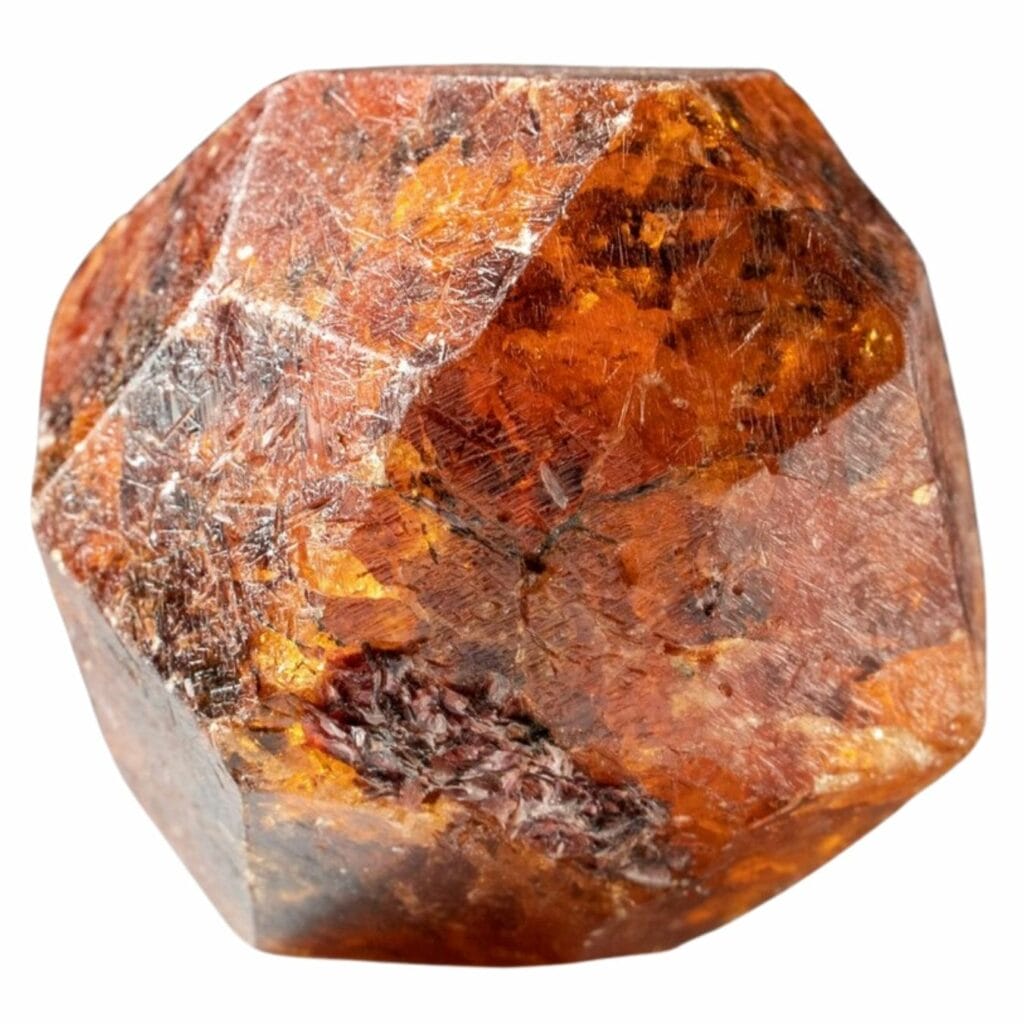
Garnet is a group of minerals known for its deep red color, although it can come in a variety of other colors too. It’s often found in small, rounded crystals that form under high temperatures and pressures, typically in metamorphic rocks.
They are made up of elements like aluminum, iron, magnesium, and chromium, which contribute to the different colors the different types of garnets can have.
One of the most striking things about garnet is its rich, vibrant colors. The most common color is a deep, red wine color, but garnets can also be green, orange, yellow, or purple.
Bright, clear garnets without many internal marks or blemishes are more valuable. The size and shape of the garnet crystals also play a role in their value. Well-formed, larger crystals are typically more sought after than smaller ones.
Garnet isn’t just a pretty stone; it’s also useful. It’s often used as an abrasive for things like sandpaper and waterjet cutting. Garnet sand is known for being very hard and sharp, making it great for cutting and shaping other materials.
Where you can find garnet in Alabama
- Ashland Mining District, Clay County
- Kowaliga, Elmore County
- Foster Mine, Randolph County
Hyalite

Hyalite is a fascinating type of opal that can be found in Alabama. It’s special because it looks like glass, with a clear or slightly milky appearance.
What makes hyalite unique is its high water content, which makes it different from other types of opal that are more colorful.
Hyalite forms in an interesting way. It usually grows in places where there’s a lot of volcanic activity. When hot water filled with silica (the same stuff that makes up quartz) moves through rocks, it sometimes leaves behind deposits of hyalite.
These deposits cool and harden over time, turning into the glassy hyalite we see.
One of the coolest things about hyalite is its fluorescence. Under ultraviolet (UV) light, it glows a bright green color. This happens because of the way the silica in the hyalite reacts to the UV light.
Hyalite has a unique look, which makes it valuable to collectors. The glassy appearance and the way it glows under UV light are really interesting to people who love rocks and minerals.
Also, because it’s not very common, finding a piece of hyalite can be exciting for collectors.
Where you can find hyalite in Alabama
- Indian Mountain, Cherokee County
Spinel

Spinel is known for its beauty and range of colors. This mineral is made of magnesium and aluminum, and it forms deep within the Earth under high heat and pressure conditions.
It can be found in a variety of colors, including red, pink, blue, and purple. The color of spinel depends on the presence of other elements, like iron or chromium, which get mixed in as the mineral forms.
What’s really cool about spinel is its durability and brilliance. It’s quite hard, which means it doesn’t scratch easily. This makes it great for jewelry that you can wear every day without worrying too much about damage.
Spinel also has a high level of brilliance, which means it sparkles a lot when light hits it.
The value of spinel comes from several factors. First, the color is a big deal. Bright, vivid colors like deep reds and vibrant blues are especially prized.
Clarity, or how clear the spinel is, also adds to its value. Fewer internal marks or blemishes mean a higher quality stone. And of course, the rarer the color of the spinel, the more valuable it is.
For a long time, spinel was often mistaken for other gemstones like ruby or sapphire. But now, people recognize it for its own unique beauty and qualities.
Where you can find spinel in Alabama
- Wood Copper Mine, Cleburne County
- Doss Mountain, Chambers County
- Easton-Dudleyville, Tallapoosa County
Tourmaline

Tourmaline is a remarkable and colorful mineral that comes in almost every color you can think of, from vivid greens and pinks to deep blues and reds. Sometimes, a single crystal can have multiple colors, which is a phenomenon called color zoning.
This can result in some really stunning patterns, making each piece of tourmaline unique. Even more amazing, some tourmaline crystals change color depending on the light.
This variety is thanks to the different elements that get mixed in with the tourmaline as it forms, like iron, manganese, or lithium.
Tourmaline is often found in igneous and metamorphic rocks, where it forms beautiful, long, slender crystals.
Color is a huge factor in determining the value of tourmaline – bright, intense colors and unique color combinations are highly sought after.
Clarity, or how clear the crystal is, also plays a part in its value, along with the quality of the crystal itself. Large, well-formed tourmaline crystals without many internal flaws or blemishes are especially prized.
Where you can find tourmaline in Alabama
- Gold Hill, Chambers County
- Delta, Clay County
- Rockford Mining District, Coosa County
The Crystals Found Here
Alabama offers an amazing range of crystals that can be found in different areas and terrains across the state. Find more information on the crystals you find with the help of our guide:
Azurite
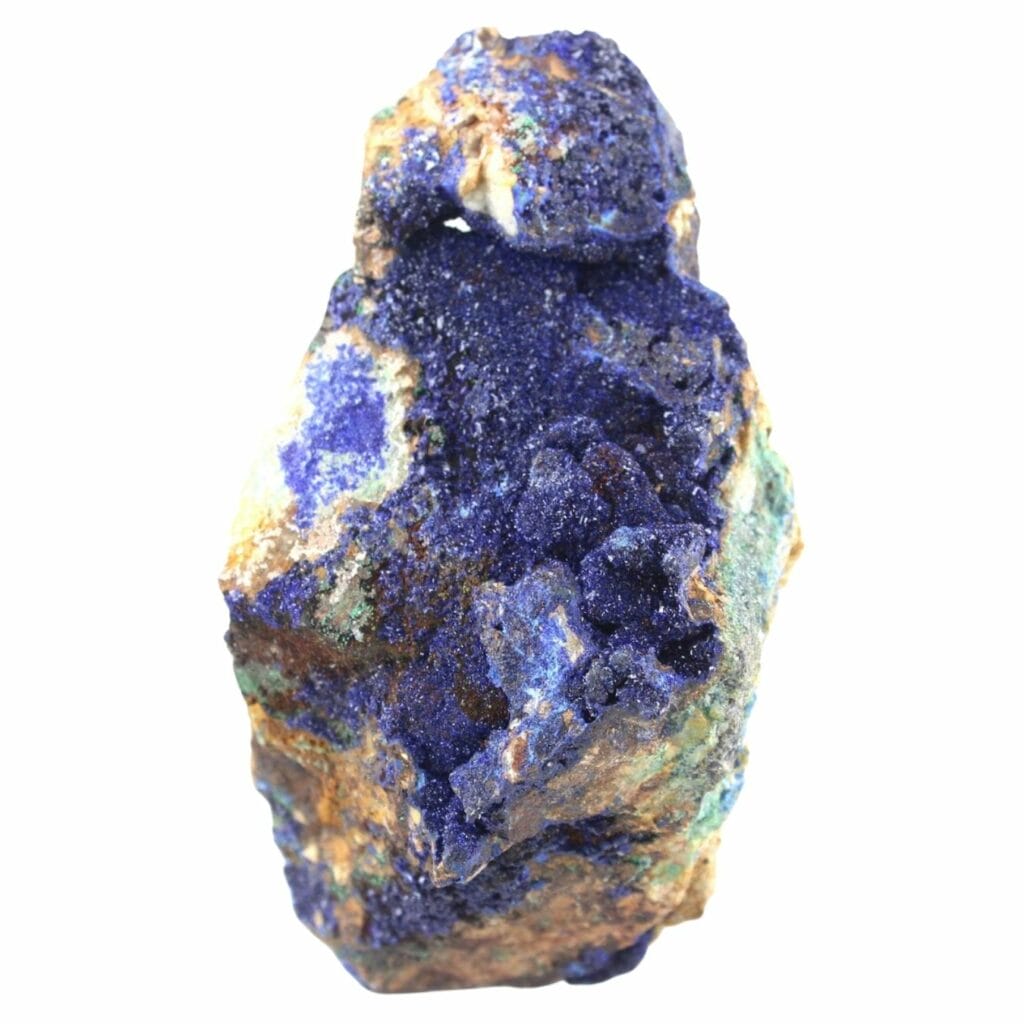
Azurite is a stunning mineral known for its deep blue color, adding a splash of brilliance to the rocks found in Alabama. It’s made of copper, carbon, and oxygen, and usually forms in places where copper-rich rocks are exposed to air and water.
This process, called weathering, changes the copper into azurite over time. You can often find azurite in the same areas as green malachite, another copper mineral, and sometimes they even grow together, creating a beautiful contrast of blue and green.
The deep, rich blue color of azurite is what makes it really stand out. This vibrant hue has been admired for centuries, and in the past, people even ground up azurite to use as a blue pigment in paints.
Nowadays, its bright color still catches the eye, making it a favorite among mineral collectors.
Color is a major factor in the value of azurite – the deeper and more vivid the blue, the more desirable the azurite.
The formation of the crystals is also important. Well-formed, sharp azurite crystals are more sought after than those that are less distinct.
Azurite’s combination with other minerals, like malachite, can also add to its appeal, creating unique and striking patterns.
Where you can find azurite in Alabama
- Coleta, Clay County
- Wood Copper Mine, Cleburne County
- St. Clair County
Chalcopyrite

Chalcopyrite is a fascinating mineral, known for its shiny, metallic luster and brass-yellow color, and it’s one of the interesting crystals found in Alabama.
It’s composed of copper, iron, and sulfur, and it often forms in places where there’s a lot of heat and pressure deep underground. Chalcopyrite is most commonly found in sulfide deposits, where it can form impressive, shiny crystals.
What’s neat about chalcopyrite is that despite its gold-like appearance, it’s actually the most important source of copper. This is why it’s sometimes called “fool’s gold,” because it can trick people into thinking they’ve found real gold.
The bright yellow color can also tarnish to a variety of iridescent hues, which adds to its appeal.
For collectors, the bigger and more well-formed the crystals, the better. If the crystals have maintained their bright, metallic luster and haven’t tarnished much, they’re more desirable.
For those in the mining industry, chalcopyrite’s value lies in its copper content. Copper is a key metal used in wiring, electronics, and many other applications, making chalcopyrite an important mineral resource.
Where you can find chalcopyrite in Alabama
- Angel Mining District, Calhoun County
- Goldville Mining District, Tallapoosa County
- Gold Ridge, Coosa County
Covellite

Covellite is a unique and striking mineral known for its deep blue to purple color. It’s a copper sulfide mineral, meaning it’s made up of copper and sulfur.
Covellite is often formed through the alteration of other copper sulfide minerals, like chalcopyrite. This can happen in different geological settings, often involving a lot of heat and water.
The appearance of covellite is what really catches the eye. Its deep indigo and sometimes iridescent colors can be quite stunning. When polished, covellite can have a metallic luster, making it look even more impressive.
The thin, plate-like crystals, often intergrown in a layered structure, give it a unique texture.
For mineral collectors, the beauty and rarity of covellite make it a prized find. The more intense and attractive the color, the more valuable the specimen.
Its rarity also contributes to its appeal, as covellite isn’t found in large quantities like some other minerals.
Covellite is also valued for its copper content. Copper is a widely used metal, important in electrical wiring, plumbing, and many other applications.
Where you can find covellite in Alabama
- Pyriton Mining District, Clay County
- Wood Copper Mine, Cleburne County
- Devils Backbone Mining District, Tallapoosa County
Galena
Galena is an important part of the various types of rocks found in Alabama. It forms in near-perfect cubic crystals and has a naturally shiny, metallic luster.
It’s made of lead and sulfur, and it often forms in hydrothermal veins where hot fluids move through cracks in rocks and deposit minerals.
What’s really cool about galena is its high density – it’s very heavy for its size, which surprises many people when they pick it up for the first time.
The cubes and other shapes that galena crystals form are also quite interesting. They have sharp angles and smooth surfaces, making them stand out among other minerals.
The perfection of its cubic crystals and its shiny metallic appearance make galena a favorite among rock collectors.
But beyond its appeal to collectors, galena is also valuable for its lead content. Lead is used in batteries, radiation protection, and in the past, was used in pipes and paint.
However, because lead can be harmful, it’s important to handle galena with care.
Where you can find galena in Alabama
- Jamestown, Cherokee County
- Millerville, Clay County
- Guntersville, Marshall County
Halite

Halite, commonly known as rock salt, is a fascinating mineral found in Alabama. It’s made entirely of sodium chloride – the same stuff that’s in table salt.
This minerals forms in areas where salty water, like from a sea or lake, evaporates and leaves behind salt crystals. Over time, these crystals build up and turn into halite.
One of the cool things about halite is its taste – it’s salty, just like the salt used in kitchens. It often forms clear, cube-shaped crystals, and sometimes these crystals can get pretty big.
Halite can also be found in different colors, like pink or blue, depending on the impurities within it.
Halite is essential in our daily lives. Salt is used in cooking, preserving food, and even in melting ice on roads in the winter. In industries, large amounts of halite are used in manufacturing and chemical production.
It’s also an interesting mineral to study because it tells us about past environments. Finding halite can indicate that an area used to be underwater.
Where you can find halite in Alabama
- McIntosh Mine, Washington County
- Salt Creek, Clarke County
- Louann Salt, Wilcox County
Pyrite

Pyrite is a shiny, metallic-looking mineral found in Alabama. It’s made of iron and sulfur and forms in many different geological environments, often in places where there’s a lot of heat and pressure.
It can be found in beautiful, well-formed crystals, and sometimes these crystals form perfect cubes, which is pretty neat.
What makes pyrite stand out is its metallic luster and gold color. These features have tricked many people into thinking they’ve found real gold, hence the nickname “fool’s gold.”
The value of pyrite comes from several aspects. For mineral collectors, the shape and size of the crystals are important. Well-formed, shiny cubes or other shapes are especially prized.
Pyrite also has a historical significance; it was used in the early days of firearms and has been found in prehistoric burial mounds, showing that it has been valued by people for a long time.
In addition to being a collector’s item, pyrite is useful in various industries. It’s used in the production of sulfuric acid and sometimes in the making of jewelry.
Where you can find pyrite in Alabama
- Woodville Quarry, Jackson County
- Pyriton Mining District, Clay County
- Devils Backbone Mining District, Tallapoosa County
Sphalerite

Sphalerite is an interesting and important mineral, especially among the various crystals found in Alabama.
It forms in different geological settings, often where hot fluids from deep in the Earth come up and deposit minerals in cracks or openings in rocks.
What’s really cool about sphalerite is the range of colors it can have. Depending on its iron content, sphalerite can be yellow, brown, red, green, or black.
It’s also known for its high dispersion, which means it can show flashes of brilliant colors, kind of like a diamond, when light hits it just right.
The color, brightness, and crystal forms are important when determining the quality of sphalerite crystals. Well-formed crystals with bright colors are especially sought after.
But sphalerite isn’t just pretty to look at; it’s also very useful. As the main source of zinc, it’s important in making things like brass and other alloys, and zinc is also used in batteries and other products.
Where you can find sphalerite in Alabama
- Cragford Mining District, Randolph County
The Most Valuable Rocks and Minerals Found In The State
Alabama is a land filled with a variety of valuable rocks and minerals, each with its own unique worth. Some of these natural wonders are valued for their stunning beauty, capturing the eyes of collectors and jewelry makers.
Others hold great importance for their practical uses in industries, playing a crucial role in manufacturing and technology.
This rich diversity makes Alabama’s geological treasures not just fascinating for their appearance, but also for the many ways they contribute to our world.
Corundum

Corundum is one of the valuable rocks in Alabama found in Alabama, known for being one of the hardest substances on Earth.
It’s made up of aluminum and oxygen and forms deep in the Earth under high temperatures and pressures, usually in metamorphic rocks.
This tough mineral can come in a variety of colors, but the most well-known are the bright red rubies and deep blue sapphires. In fact, all red corundum is called ruby, and all other colors are called sapphire.
What’s really cool about corundum is its hardness. It’s the second-hardest natural substance after diamond. This makes it very resistant to scratches and wear, which is why it’s so popular in jewelry.
The only thing that can really scratch corundum is another piece of corundum or a diamond.
Corundum crystals with bright, clear colors are more sought after and can be worth a lot. Crystals with good clarity and fewer marks and blemishes inside are typically more valuable.
And of course, the rarity of the color and the size of the corundum piece also play a part in its value.
Corundum isn’t just valuable for making beautiful jewelry; it also has some practical uses. Because of its hardness, it’s used in industrial tools like grinding wheels and cutting tools.
Where you can find corundum in Alabama
- Doss Mountain complex, Chambers County
- Alexander City, Coosa County
- Easton-Dudleyville area, Tallapoosa County
Gold
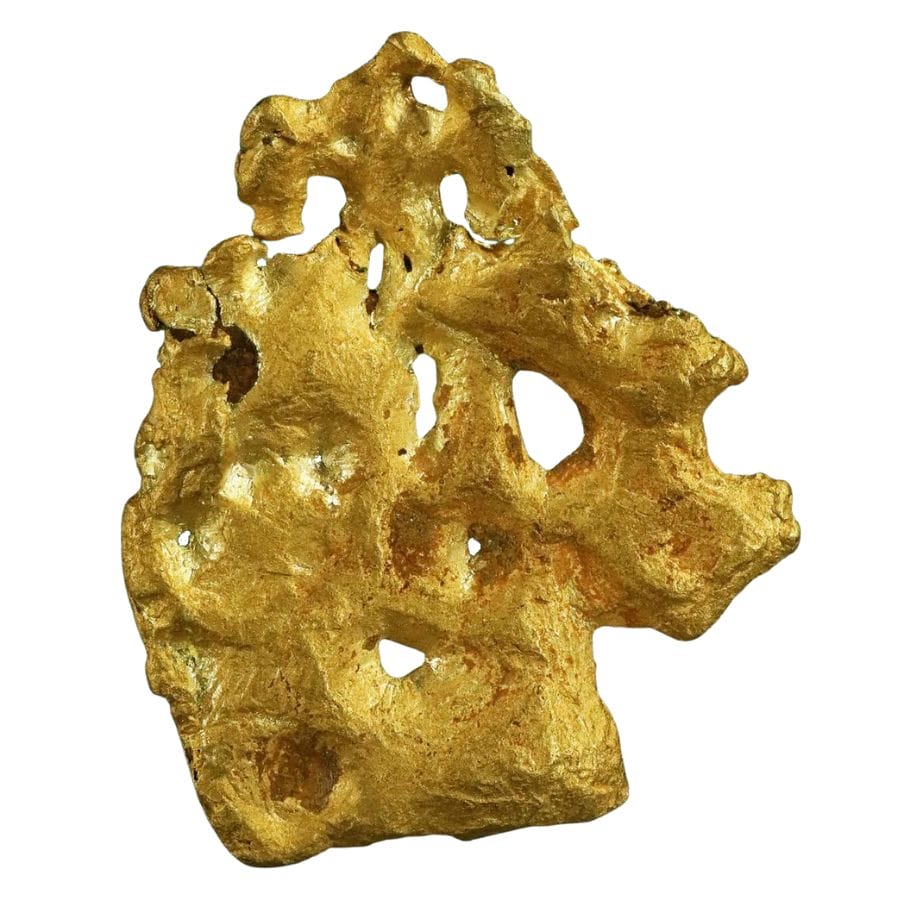
Gold is shiny, yellow, and doesn’t rust or tarnish, which is part of what makes it so special. It forms deep within the Earth, usually in quartz veins where hot fluids circulate through rocks and deposit minerals.
Over millions of years, these deposits cool and harden, eventually forming gold that can be found near the surface.
One of the coolest things about gold is its rarity and the way it looks. Its bright, shiny appearance has caught people’s attention for thousands of years.
Gold is also very malleable, meaning it can be shaped easily without breaking. This makes it perfect for making jewelry and other decorative items.
Because gold is rare, it’s valuable. Even tiny flakes of gold can be thrilling to discover. It also looks beautiful, so it has been a popular choice for jewelry and decorations for a long time.
Gold is also very useful in technology; it conducts electricity and doesn’t corrode, making it ideal for use in electronics like computers and smartphones.
Where you can find gold in Alabama
- Tallapoosa River, Clay County
- Talladega National Forest
- Cholerine Mining District, Cleburne County
Hematite
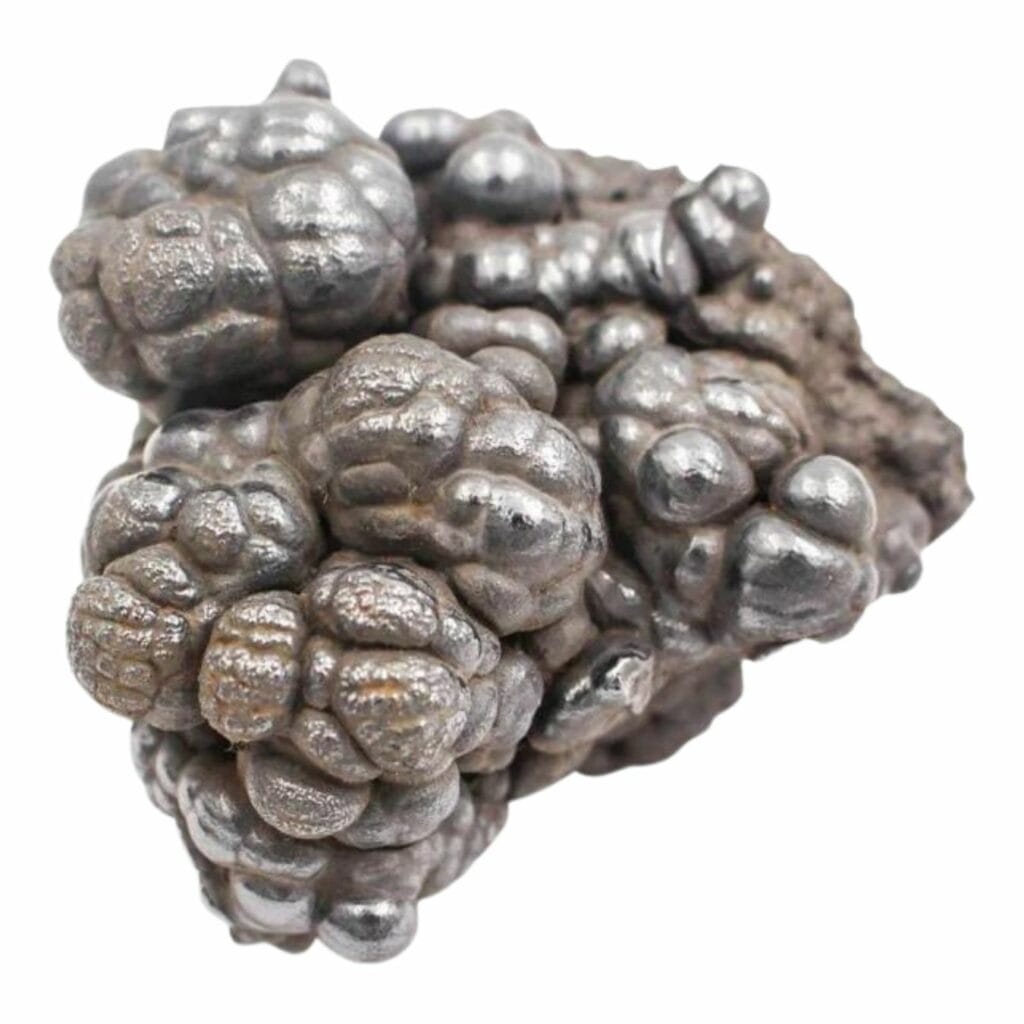
Hematite is a fascinating mineral that has a unique, shiny, metallic appearance and reddish-brown color. It forms in a variety of ways, often in environments rich in iron.
When iron and oxygen mix in water or are exposed to the air, they create hematite over time. This process can happen in many places, like near water bodies or within iron-rich soils.
One of the most noticeable things about hematite is its density and weight. It feels heavier than it looks, which is always a surprise when you pick it up.
Its shiny surface, which can be polished to a mirror-like finish, makes it popular for jewelry and decorative items.
Hematite’s red-brown streak, which is the color it leaves when rubbed on a surface, is another distinctive feature.
The value of hematite goes beyond its appearance. It is an iron ore, which means it’s a main source of iron.
This makes hematite incredibly valuable in many industries. Iron from hematite is used to make steel, which is essential in building structures, making cars, and manufacturing various products.
This industrial importance significantly increases the value of hematite.
Where you can find hematite in Alabama
- Compton Mine, Blount County
- Gaylesville, Cherokee County
- Gadsden Mining District, Etowah County
Petrified Wood

Petrified wood is what happens when wood from trees turns into stone over a really long time. When trees fall and get buried under stuff like mud or ash, minerals in the water slowly replace the wood parts with stone.
Even though it turns to stone, it keeps the shape, texture, and even sometimes the rings of the original tree.
In Alabama, petrified wood is extra special because a lot of it is covered with a layer of druzy quartz.
Druzy quartz consists of tiny sparkling quartz crystals. This layer of quartz adds an amazing glittery look to the petrified wood, making it even more interesting.
This sets Alabama’s petrified wood apart from other petrified wood specimens. It’s not just cool to look at; it also tells us about the past. It can give us clues about what kinds of trees were around a long time ago and what the environment was like.
Also, it’s not every day you find a piece of wood that’s turned into stone. And the druzy quartz on Alabama’s petrified wood makes it even more unique.
Where you can find petrified wood in Alabama
- Brilliant, Marion County
- Uphape Creek, Macon County
- Tuscaloosa, Tuscaloosa County
How to Identify The Rocks and Minerals You Find
From the colorful quartz to the deep red garnets, each rock and crystal has unique features that set it apart. Understanding Alabama rock identification involves exploring their colors, hardness, and even the way they react to light.
UV Light Testing
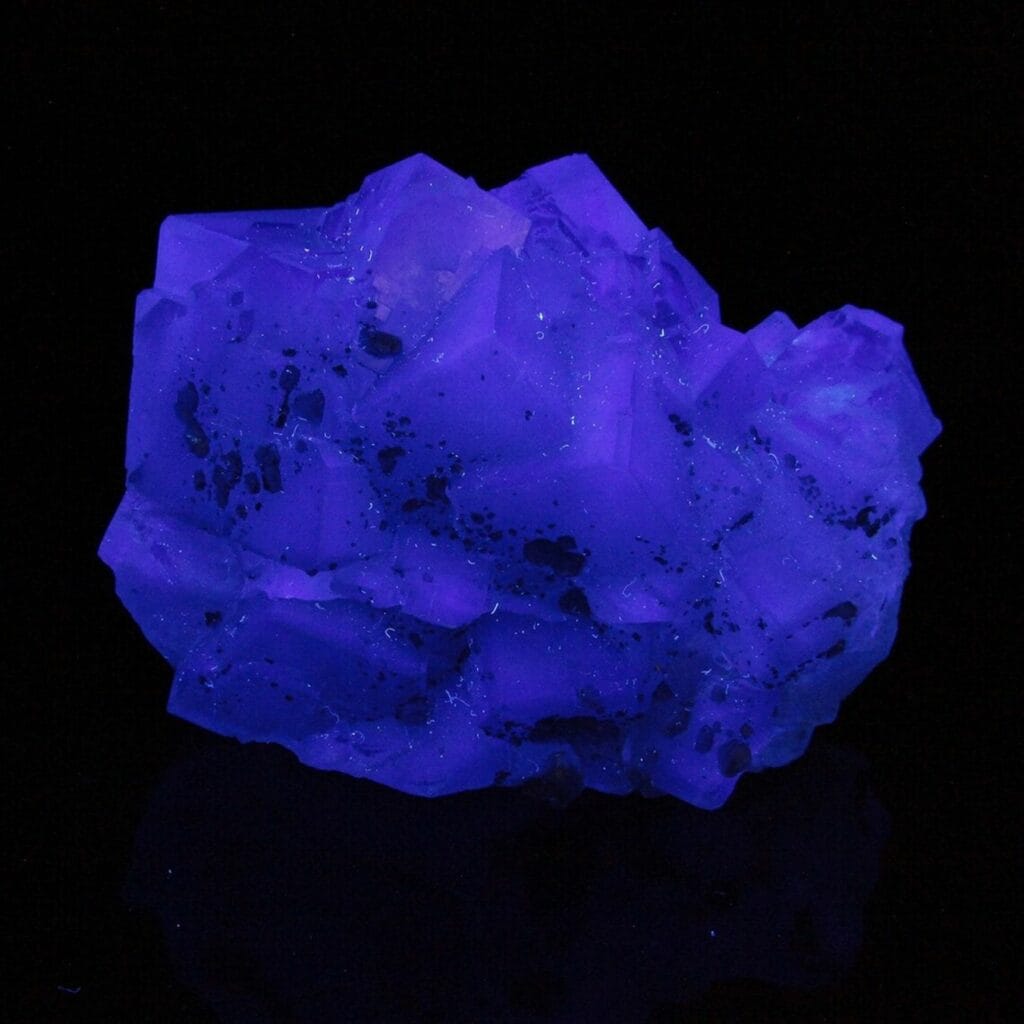
When certain minerals are put under ultraviolet (UV) light, they glow with different colors. This glow is called fluorescence.
It happens because the minerals absorb the UV light and then emit it back in visible colors. This special feature can help tell one mineral from another.
To test for fluorescence, a UV light, often a small, handheld lamp, is used. In a dark room, when the UV light shines on a mineral, it might light up with bright colors.
Not all minerals will fluoresce, but those that do can show a range of colors. For example, calcite often glows red or blue, while fluorite can glow a bright green or blue.
The color of fluorescence can help identify a mineral. Each mineral has a specific set of colors it can fluoresce, depending on its composition.
Also, the intensity of the glow can vary. Some minerals might glow very brightly, while others have a fainter light.
Acid Test

Identifying rocks and minerals can sometimes be as easy as watching them fizz. This is especially true for rocks and minerals found in Alabama, where carbonate minerals like calcite are common.
A cool way to see if a rock is a carbonate mineral is by using a drop of dilute hydrochloric acid. This simple acid test is a neat trick used by geologists.
Here’s how it works: when a tiny drop of the acid touches a rock that has carbonate minerals, it reacts and creates bubbles. This reaction is called effervescence. It’s like seeing soda fizz up when you open it.
The acid test is handy because it’s quick and pretty clear. If there are lots of bubbles, it means there’s a good amount of carbonate in the rock. If there are only a few bubbles or none at all, then the rock might be made of something else.
Magnetism Test

Not all minerals are magnetic, but some, like magnetite, really stand out because they are attracted to magnets. This magnetic quality can be a big clue in figuring out what kind of mineral you’ve got.
To test a mineral’s magnetism, all you need is a simple magnet. Hold the magnet close to the mineral and see if there’s any attraction. If the mineral jumps to the magnet or sticks to it, it’s magnetic.
This is a super easy and quickntest, especially if you’re out exploring and finding new rocks and minerals.
Magnetite is one of the most common magnetic minerals. It’s usually a black or dark brown color and is strongly attracted to magnets. If a rock sticks to a magnet, it might be magnetite.
Hardness Test
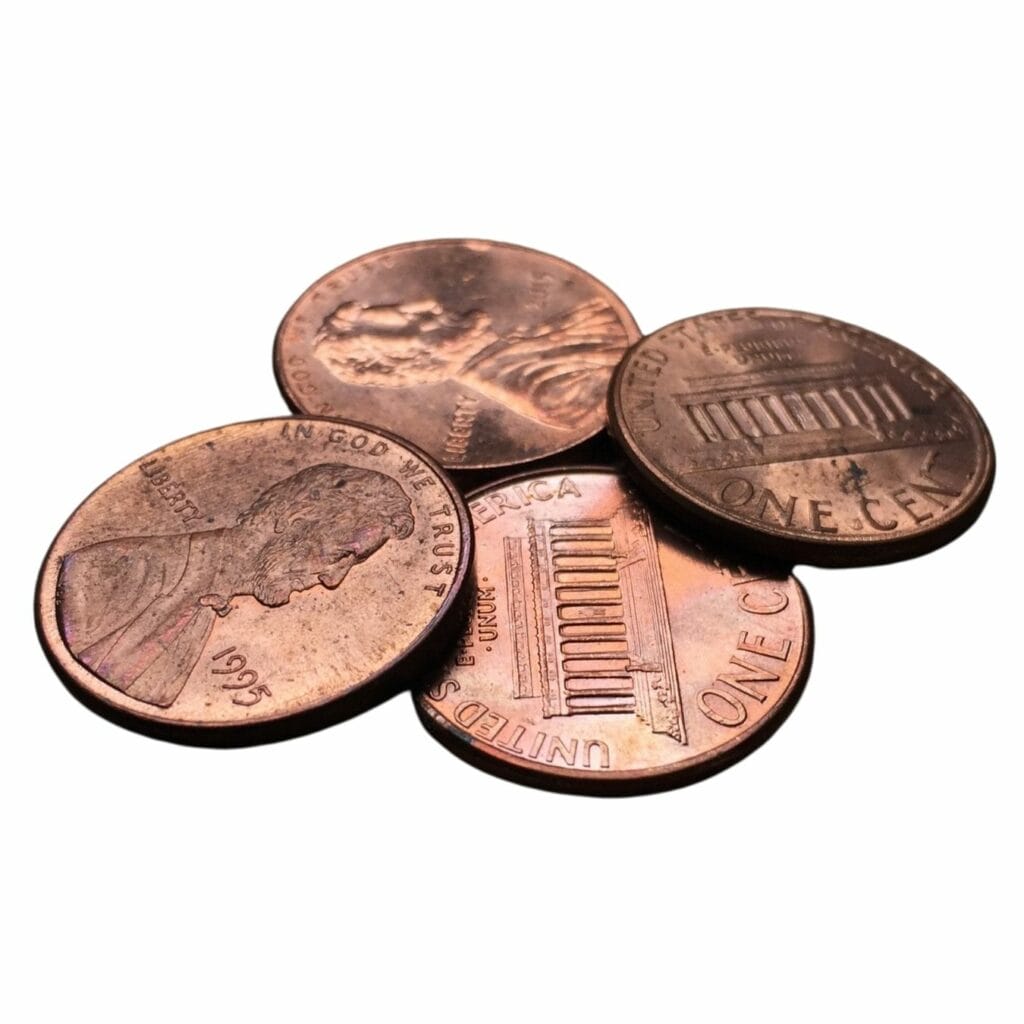
Hardness refers to how easy it is to scratch the surface of a mineral. Geologists use something called the Mohs scale to measure this. The scale goes from 1 to 10, with 1 being very soft and 10 being super hard like a diamond.
To test hardness, you can use common objects. For example, a fingernail has a hardness of about 2.5. If a mineral can be scratched by a fingernail, it’s pretty soft.
A copper penny has a hardness of around 3, and a steel file is much harder, around 6.5. If a mineral can scratch glass, which has a hardness of about 5.5, then it’s pretty hard.
When you’re testing, it’s important to see what scratches what. If the mineral scratches the object, it means the mineral is harder.
But if the object scratches the mineral, the mineral is softer. This test helps figure out what kind of mineral you’re looking at because each mineral has a specific hardness range.
Streak Test
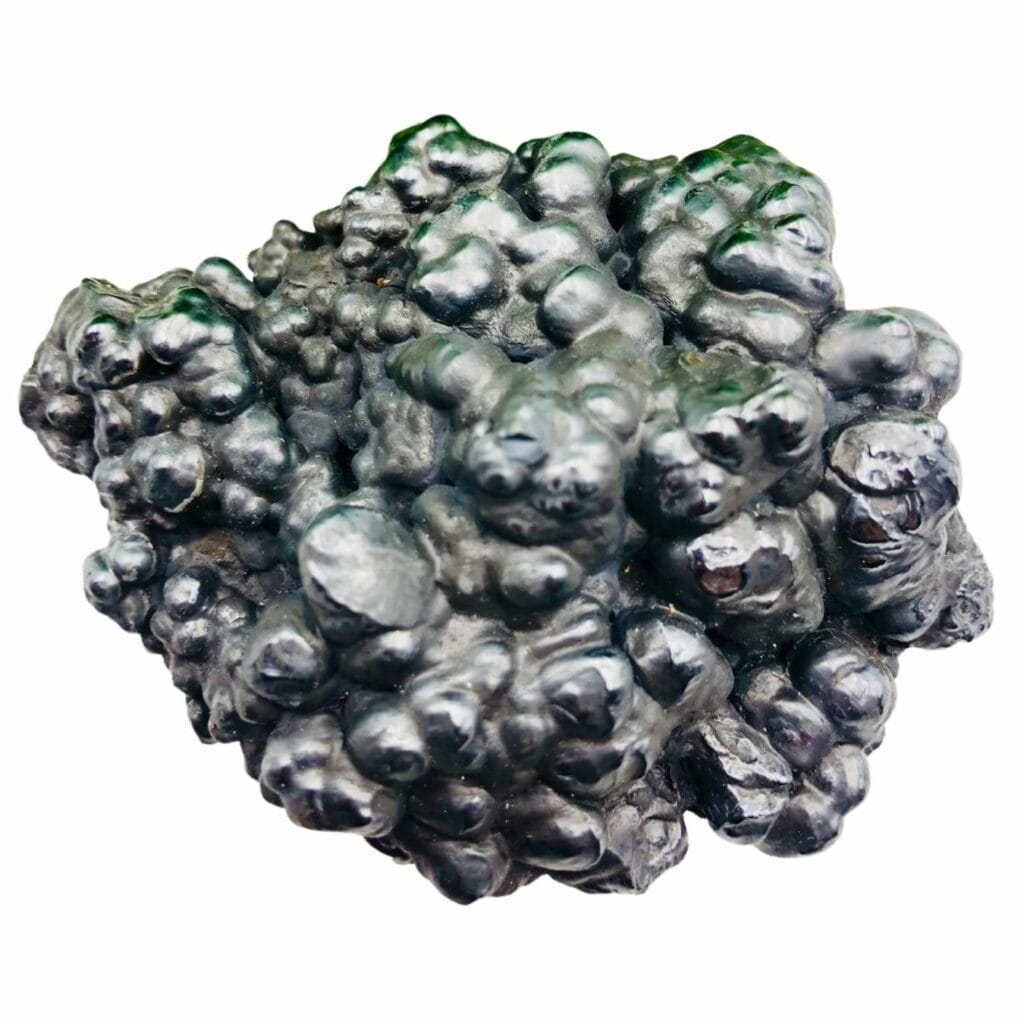
When it comes to Alabama rock identification, checking a mineral’s streak is a great method. Streak is the color of the mineral’s powder.
Even though a mineral might look one color on the outside, the streak can be a totally different color. This can be a big hint in figuring out what the mineral is.
To test a mineral’s streak, you rub it across a piece of unglazed porcelain, like the back of a tile. This is called a streak plate.
When the mineral is rubbed on the plate, it leaves a powder line, which is the streak. This streak shows the true color of the mineral.
The cool thing about the streak test is that the color of the streak doesn’t change, even when the color of the mineral can be different.
For example, hematite can look black or silver, but it always has a reddish-brown streak. This makes the streak test really reliable.
Some minerals have a very light streak, like white or colorless, and some have a darker streak. By comparing the streak color to known mineral streak colors, you can get a good idea of what the mineral might be.


